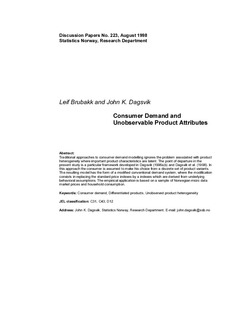| dc.contributor.author | Brubakk, Leif | |
| dc.contributor.author | Dagsvik, John K. | |
| dc.date.accessioned | 2011-10-09T21:43:30Z | |
| dc.date.available | 2011-10-09T21:43:30Z | |
| dc.date.issued | 1998 | |
| dc.identifier.issn | 1892-753x | |
| dc.identifier.uri | http://hdl.handle.net/11250/180321 | |
| dc.description.abstract | Traditional approaches to consumer demand modelling ignores the problem associated with product heterogeneity where important product characteristics are latent. The point of departure in the present study is a particular framework developed in Dagsvik (1996a,b) and Dagsvik et al. (1998). In this approach the consumer is assumed to make his choice from a discrete set of product variants. The resulting model has the form of a modified conventional demand system, where the modification consists in replacing the standard price indexes by a indexes which are derived from underlying behavioral assumptions. The empirical application is based on a sample of Norwegian micro data market prices and household consumption. | |
| dc.language.iso | eng | en_US |
| dc.publisher | Statistics Norway | en_US |
| dc.relation.ispartofseries | Discussion Papers;No. 223 | |
| dc.subject | Forbruksforskning | en_US |
| dc.subject | Etterspørsel | en_US |
| dc.subject | Forbrukere | en_US |
| dc.subject | Dagligvarer | en_US |
| dc.subject | Priser | en_US |
| dc.subject | Consumer demand | en_US |
| dc.subject | JEL classification: C31 | en_US |
| dc.subject | JEL classification: C43 | en_US |
| dc.subject | JEL classification: D12 | en_US |
| dc.title | Consumer demand and unobservable product attributes | en_US |
| dc.type | Working paper | en_US |
| dc.subject.nsi | VDP::Social science: 200::Economics: 210 | en_US |
| dc.source.pagenumber | 33 s. | en_US |
